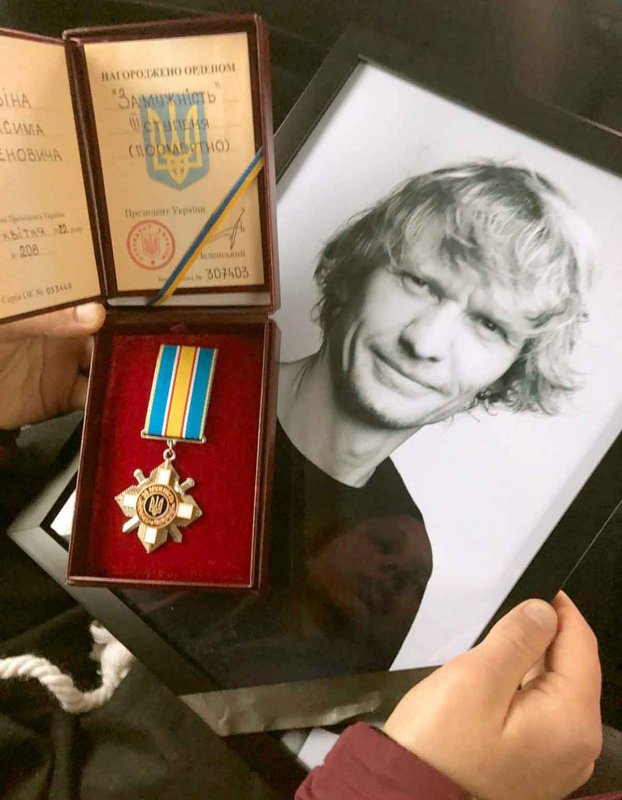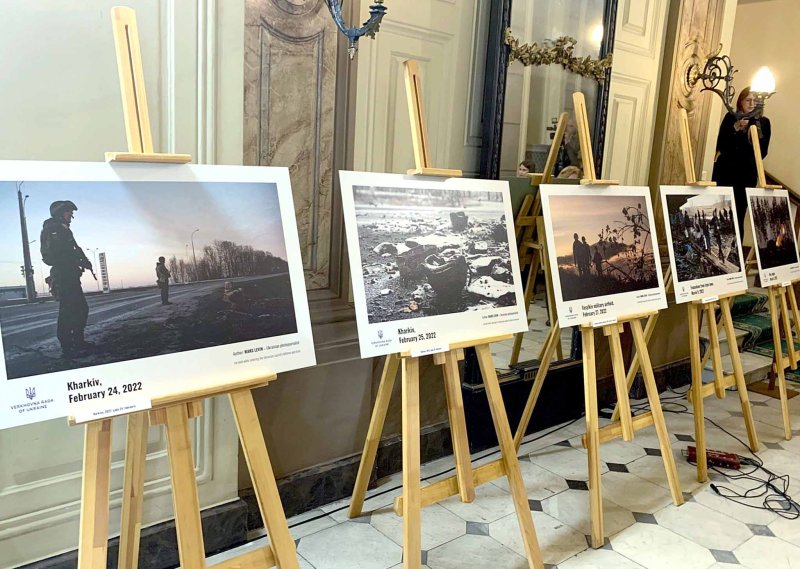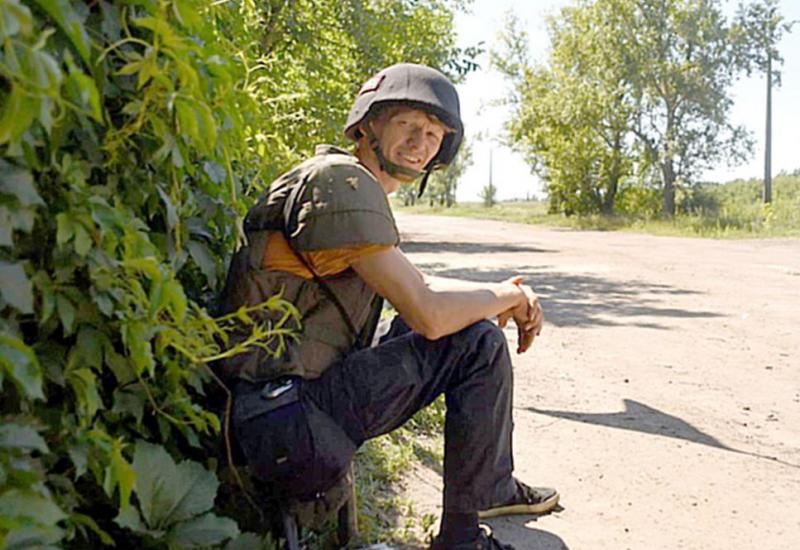Ukrainian photojournalist and documentary filmmaker, Igor Sikorsky Kyiv Polytechnic Institute graduate Max Levin, who created dozens of photo and video projects, was posthumously awarded the Order of Courage "for personal courage and selfless actions shown during the coverage of Russian aggression." A street in Solomianskyi district was also named in his honor.
He is known as a photojournalist, documentary photographer and cameraman for many Ukrainian and international publications. For more than 10 years, Maksym worked at LB.ua, and also collaborated with Reuters, BBC, TRT World, Associated Press, and Hromadske. His photos have been published by the Wall Street Journal, TIME, Breaking news Poland, EU AGENDA, World news, The Moscow Time, Correspondent.net, ELLE, TV-24, Radio Bulgaria, Ukraine Crisis Media center, Vatican news, Radio Liberty (RFE/RL). Most of his documentary projects are related to the war in Ukraine.
To stop the war. "He went to work in the middle of hell. He was a man who really loved his job. Max advocated for more journalists to be allowed to go to the front so that they could show the world the real situation. He was very brave and knew exactly what he was doing. You could always rely on him," say his colleagues. Levin often cited the example of a famous black-and-white photograph by Nick Watt taken in 1972 during the Vietnam War. The photo shows a little naked girl crying and running away from a napalm bombing. "This photo helped stop the war. Probably, every Ukrainian photographer dreams of taking a photo that will stop the Ukrainian war as well," the journalist said.
On his dream. "I dreamed of becoming a photographer since I was 15," Maksym once recalled. "My classmate's father was a photojournalist, and a sports reporter at that. He traveled to the Olympics, World Cups, and Champions League, and took his children to the stadium. I could only dream of such a profession. I had a Kyiv SLR and attended a photography club. After graduating from high school, I thought, "I want to be a photographer." But at first, at the request of my parents, I went to get a "decent profession".
It is worth noting that at that time it was not just a decent profession, but a very decent one at the Department of APEPS of the TEF (now IATE), which included the Aprodos Research Institute. In the 1980s, the scientists of this institute carried out important scientific developments related to the Buran aerospace project, an analog of the American Shuttle, which culminated in a launch experiment. The developers were awarded the State Prize of Ukraine. And their students, as before, "can perform almost all tasks requiring the use of computers and information technology, and are able to adapt to constant changes and improvements in computer technology." It was there that Maksym received his higher education in Automated Systems Software and the qualification of a computer systems engineer.
After receiving his diploma, he followed his calling to journalism, to overcome the difficult steps of a photojournalist, to gain experience, skill and recognition. How many of them are there - who grew up, courageously tested their wings at Igor Sikorsky Kyiv Polytechnic Institute, and then became leaders in various fields. But they always remembered their alma mater with respect and gratitude. At first, Maksym worked for little-known publications, then for the Kyivski Vedomosti newspaper, UNIAN, and Gazeta 24. Then he freelanced for Focus, Profile, Ukrainian Week, and the Associated Press.
A dangerous profession. It seems that over the past two decades, there hasn't been a single significant event in Ukraine-from the Verkhovna Rada meetings to the confrontation with thugs on the Maidan to ATO operations-where Max and his camera haven't appeared. He had a reliable guardian angel: he miraculously did not fall into the clutches of titushky on the night of February 18-19, 2014 (he was charging his equipment, got delayed, and his colleagues were injured), and in August he escaped from the hell of the Ilovaisk cauldron by an even greater miracle: He came under fire twice on the highway, was wounded, lost his bearings, drove to the DNR post, escaped from the dumbfounded separatists and returned to Kyiv in a completely riddled, blood-stained car. He was also involved in high-profile scandals and investigations. A criminal case for disclosing the text messages of an MP who fabricated a case in defense of his son, who was under investigation for having injured his girlfriend; a terrible accident caused by a drunken Ukrzaliznytsia official, when the journalist's family was injured, and others. By the way, Maksym is survived by four minor sons, the last born without a father. And he wanted a daughter so badly.
"Maksym's love for children has always aroused surprise and admiration. You don't often see men loving their children so much. His sons called him very tenderly, in a childlike way, changing his name a little. If everyone was taught to raise and love their children like this in childhood, our world would be a much better place. Maksym lived by them and with them. And all his boys are very much like their father," his friends say.
On the front line. The editor of the publication where Maksym worked until recently recalls: "We worked together for ten years. As an editor-in-chief and a journalist, as two reporters. Our last meeting was two days before the war. He had foreseen and prepared for everything, complaining that journalists would not be accredited: "The war is about to start. I have to be in the epicenter. The Russians will probably resort to violence, there will be war crimes, and we have to document and record all this. Including for future trials." I knew that he would get into the epicenter. The last photos are from Irpin. On March 13, he stopped contacting us. We searched everywhere - among the prisoners, in the lists, without lists, in every way. To no avail."

On March 10, M. Levin lost his drone in the forest near the village of Moshchun while trying to record the moments of Russia's military invasion of the area. Three days later, he returned with a friend, looking for his device, convinced that the last pictures were very important... His body was found on April 1 in a forest near Huta Mezhyhirska, north of Kyiv.
Investigators from Reporters Without Borders (RSF) spent more than a week gathering evidence about the circumstances of their colleague's death. Together with Ukrainian security forces, RSF managed to identify the crime scene. Mr. Levin's charred Ford Maverick was still there. Investigators were not able to answer all the questions, but put forward hypotheses about how the events could have developed. The organization hopes that over time, the evidence collected will allow them to identify the perpetrators. RSF Secretary General Christophe Deloire noted that "the analysis of the crime scene photos and the recovered physical evidence clearly point to an execution." He added that Max Levin and his friend paid with their lives for reliable information, so the RSF will fight to identify and find the killers.
On April 4, we said goodbye to Max Levin at St. Michael's Cathedral and at the cemetery in Boyarka, where he is buried. He was a brilliant photographer. "He photographed as if through the eyes of God," his colleagues say of him. He would have turned 42 this summer. The second July 7 in a row when there is nowhere to call with congratulations.
A chronicle of war. Max was a special person, with a special talent for seeing details and feeling people, with a rare sense of justice and an equally rare conscience. His works are, in fact, a chronicle of the warring Ukraine and the heroism of Ukrainians from 2014 to the present day. The world learned the truth about Russia's war against Ukraine thanks to his work and talent. I want this work to live on, to be disseminated, so that his works continue to tell the stories that their author wanted to tell the world. Here are some of them:

The Afterilovaisk project, essentially an encyclopedia of the exploits, heroes and tragedies of Ilovaisk: https://bit.ly/3v3VR2A
A general collection of Max's photos: https://bit.ly/3Kt93Vk
And all his talented reports from the war for the Left Bank - LB.ua: https://bit.ly/3JrBqSu. This is a mosaic of human destinies, crippled by war, which only Max could see and tell so carefully.
For reference: On June 8, 2022, it was 50 years since Associated Press photographer Nick Watt took one of the most defining photographs of the Vietnam War. For this photo, White won the Pulitzer Prize in 1973 and the World Press Photo competition. The Terror of War, also known as Napalm in Vietnam, is ranked 41st in the list of the one hundred most influential photographs of the 20th century by Columbia University. Wat, along with other journalists, was near the village of Trang Bang, occupied by North Vietnamese troops. South Vietnamese planes flew overhead and dropped four napalm bombs. A few moments later, a group of frightened people, including children, ran out onto the road where the journalists were. That's when White managed to take a photo. In the foreground on the left is a boy screaming in terror. To the right, two other children are running, holding hands. In the center of the picture is a naked girl. Soldiers are walking slowly behind the children. Immediately after the shooting, Wat took the children to the hospital. Older people remember this photo, which, without exaggeration, was published in all the world's publications.

